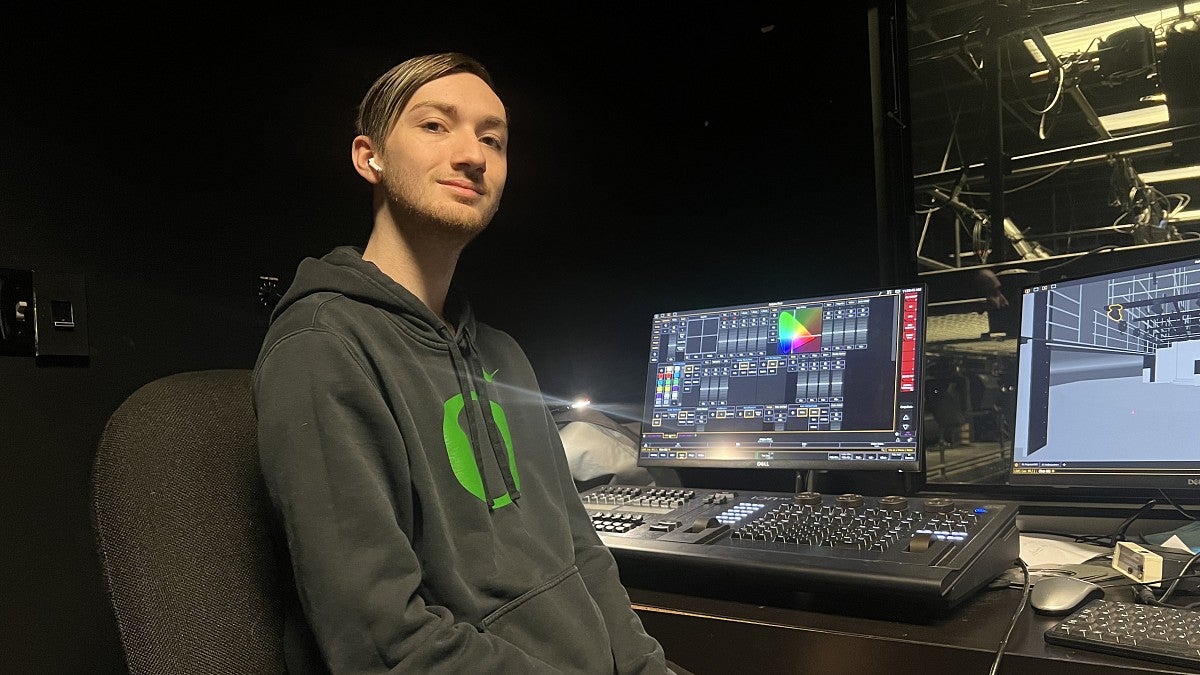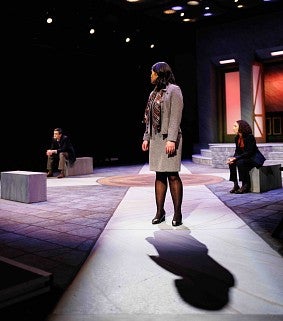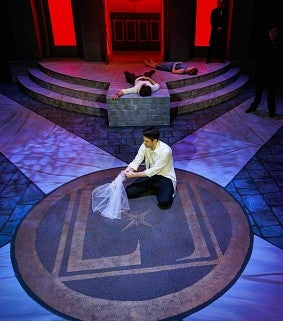
April 9, 2024 - 10:00 a.m.
The University Theatre’s latest production, Antigone, was lit—literally.
While all stage productions incorporate lighting design, Antigone was special because it premiered the new state-of-the-art set of automated lights installed in the first weeks of 2024.
Before the new lights were installed, University Theatre productions relied on an older set of conventional lights, which are fixed and less flexible. A new set of lights provides students with the latest technology, is more flexible and runs from a computerized board. Stage productions and lighting design now offer students experience with the tools used in professional theatres.

After struggling to find the funds to bring the lighting system up to date, in winter 2023, the Department of Theatre Arts launched a fundraising campaign to buy a full set of new automated lights for its stages at the Miller Theatre Complex. With a price tag of $80,000, the department raised $40,000 in donations through DuckFunder and $40,000 from College of Arts and Sciences Dean Chris Poulsen contributed from his dean’s fund.
“The new lighting system brings UO’s theatre arts department further into the 21st century,” said Janet Rose, senior instructor, theatre arts. “Students can learn how to use them, not only technically, but also how to use them to enhance a production.”
The power of lighting design
In theatre, lighting is used to draw attention to where the director wants attention, taps into the subconscious experiences of audience members and can play with an audience’s emotions.
“The colors and vibrancy of light help amplify what’s happening on stage,” said Jordan Hamlin, a theatre arts junior studying lighting design. “The new lights provide opportunities to add layers to lighting design, more flexibility, and we can use them in multiple ways.”
With the state-of-the-art lights at the Miller Theatre Complex’s two theatres, designers can add layers of light to create textures on the floor, appearing like water or moonlight. And rather than be stuck with the conventional fixed spotlight, the automated lights can combine and move to bring more dynamic attention to a person on stage, tracking the actor’s movement on stage.

“The new lights allow us to play with the dynamics a bit more,” Rose said. “Students can use the lights to bring more reality and depth to a show and to allow the audience to subconsciously accept what they’re seeing on stage as reality.”
Anyone who has attended a live event, whether it’s a play, a musical theatre production or a concert, has experienced the power of light, consciously and subconsciously. Color changes can turn day into night on stage, and light alterations can set a scene with cooler colors indicating a colder temperature and warmer colors mimicking the presence of the sun.
“Lights are the entrance into the show—house lights go down and BAM! Lights up and the first moment of the show begins,” Rose said.
Hands-on experience for lighting design students
The lighting design process starts early—usually before actors are cast. Directors may add lighting cues to the script, discuss their vision with the lighting design team and provide mood boards or inspirational photos. The lighting team uses all this information to get the overall feel and creates a 3D CAD file that outlines and visualizes the planned colors and lighting effects.
When the new lighting system was installed and to prepare for Antigone, Hamlin went to work on the lighting board, self-teaching the keyboard shortcuts, practicing and experimenting with the lights, and looking for the right amount of enhancement without abusing the power of the new lighting system.
“There’s a lot more work that goes into it than people realize and how much it changes the performance,” Rose said. “A show is going to feel wrong with the wrong lights and lighting design.”
—By Jenny Brooks, College of Arts and Sciences
